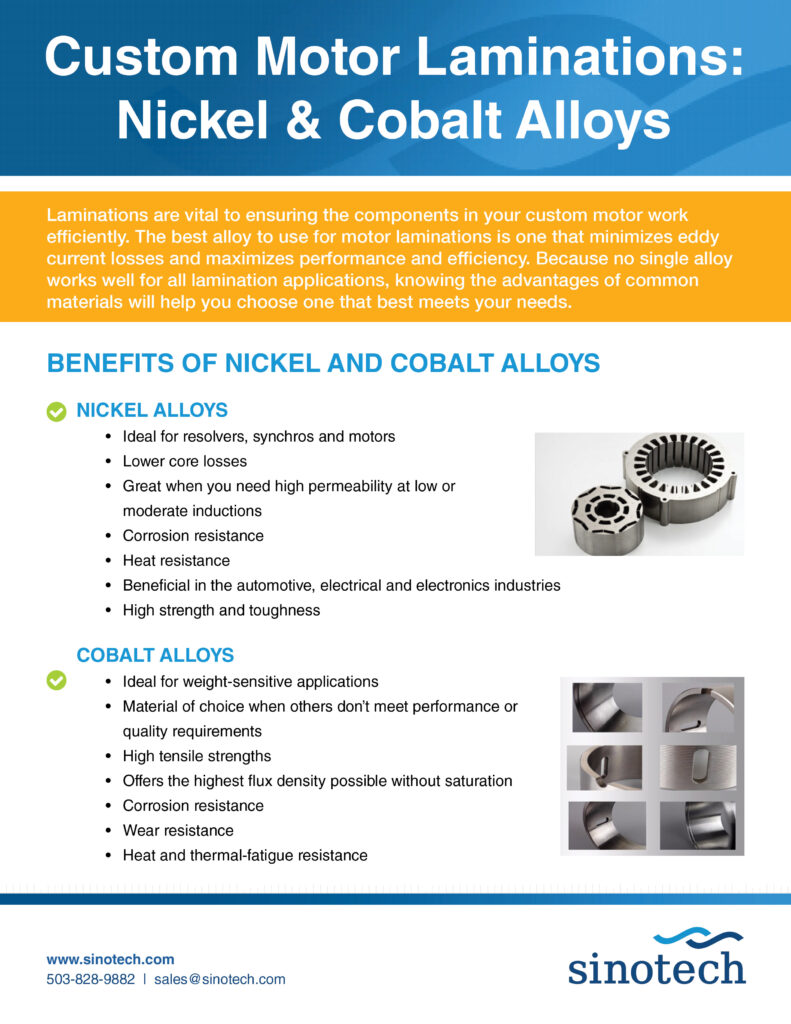The materials used to make custom motor components matter. They’re vital to an application’s design and performance, as well as the motor’s cost. In regard to motor laminations, alloys contribute to a component’s output, size and weight, which are determined by the material’s permeability, saturation flux design, and core losses. While electrical steel laminations are a common go-to choice for custom motor components, those made with nickel or cobalt alloys offer benefits that may be better suited for an application.
Understanding the differences will help you make an educated decision regarding the best alloy for your needs.
Reducing Eddy Currents with Motor Laminations
Laminating is the process of manufacturing a material in several layers. This allows the composite material to have improved stability, strength and other qualities that matter to a component’s
engineering and design. In motors, laminations are made of thin sheets of electrical steel that are punched out using a stamping press, stacked together, and are welded or banded. They are generally used for stators, rotors and transformers. Motors are manufactured by stacking laminations into lamination stacks, or lam stacks.
Engineers use laminations for motor components instead of solid materials to reduce eddy current losses. BLDC motors contain a ring-shaped magnetic core that rotates within a magnetic field. The rotation generates a voltage in the coils referred to as an eddy current, a type of magnetic loss. Several factors contribute to power losses attributed to an eddy current flow, including the resistance of the materials used.
Because eddy current losses occur in cross-sectional areas of a material, engineers use several thin sheets of an alloy, electrically insulated from each other, to minimize it. Unlike solid, larger pieces of materials, laminations generate a higher resistance and, therefore, fewer eddy currents.
The primary material used in all laminations is low-carbon steel. When designing your own custom motor, Sinotech can produce custom laminations made of any material. In addition to making laminations for the custom motors we manufacture, our factories sell just the stacks. Our manufacturing processes also produce small laminations with highly complex geometries. Laser-cut prototypes are gladly available upon request.
Nickel Alloys for Custom Motor Components
When used for rotating electrical equipment and demanding applications, nickel alloys typically contain iron and 49 percent pure nickel or 80 percent pure nickel. The alloy has lower core losses and is a good choice when you need high permeability. Nickel alloys are a good choice for resolvers, motors and synchros.
Nickel alloy laminations are more expensive than silicon steel and require special measures during the annealing process to achieve the desired properties and maintain quality. For the best results, manufactures expose the alloy to a dry hydrogen atmosphere and add surface insulation (aluminum oxide and magnesium oxide) during the annealing process because the alloy is exposed to temperatures greater than 2000°F. Since annealed nickel is fragile, it’s important to use an experienced, reputable manufacturer.
Cobalt Alloys for Motor Laminations
Cobalt alloy is an appropriate choice when other materials do not meet quality and performance requirements or when applications require high flux densities without saturation. As a result, the alloy is good for weight-sensitive applications that require less metal to carry the flux.
Cobalt alloys contain between 48 and 50 percent cobalt, iron, and 2 percent vanadium. The material has a high tensile strength and can have saturations as high as 23 kG. Like nickel alloys, cobalt alloys are higher in cost and require careful annealing after stamping. If temperatures during the annealing process exceed specifications, the alloy will lose its magnetic properties. The alloy’s cooling rate is also an important consideration to minimize losses. Because annealing temperatures and cooling rates vary by material supplier, it’s a good idea to consult with a supplier before the annealing cycle begins.
From the aerospace to the automotive industry, motor laminations serve a variety of important functions to maintain a component’s efficiency, strength and reliability. Sinotech offers comprehensive steel lamination offerings for your custom motor needs. Our specialists will guide you throughout the design process to prepare the components for manufacturing. At the factory, we’ll ensure your laminations are made with quality alloys and perform according to your exact specifications. Talk to one of our specialists today to learn more.

